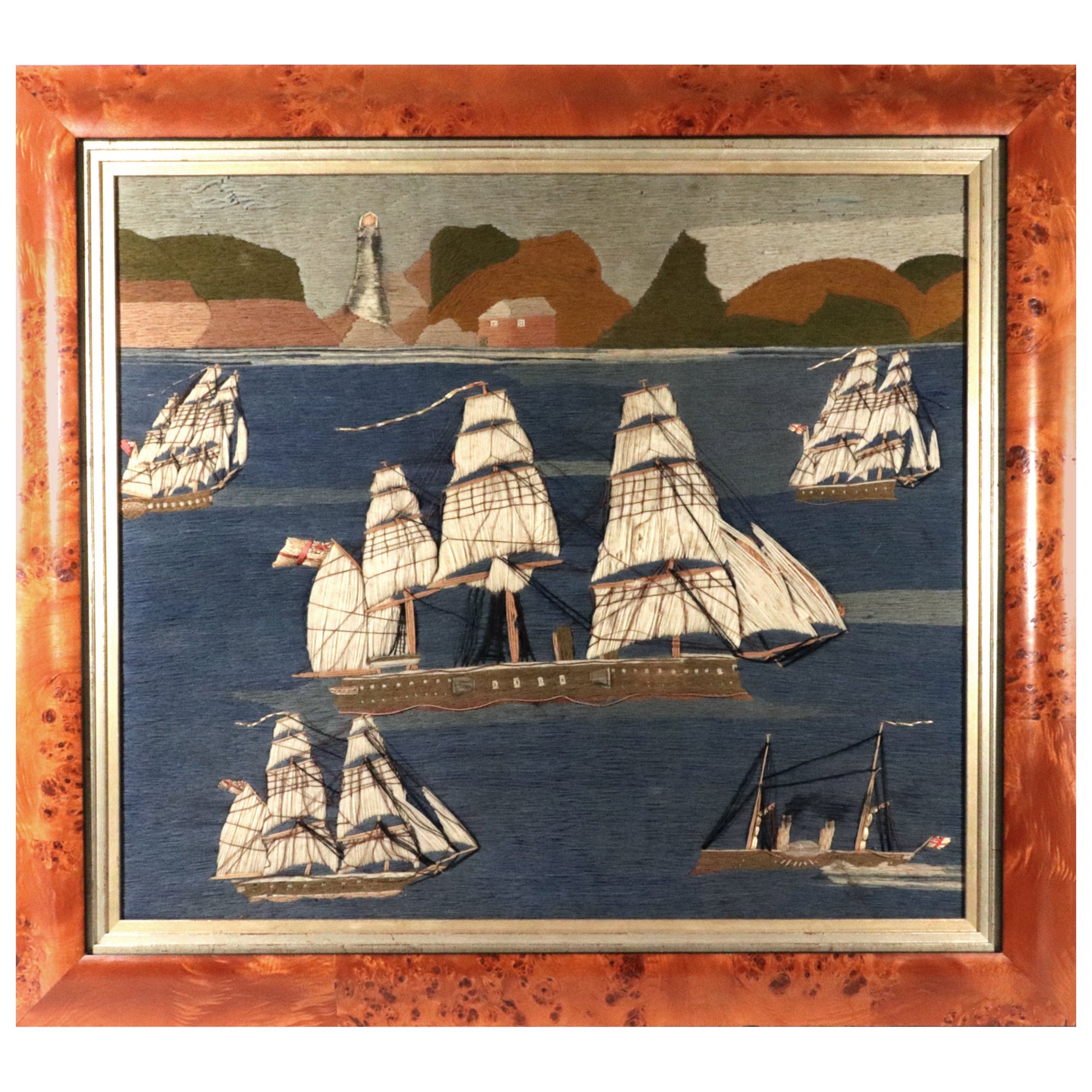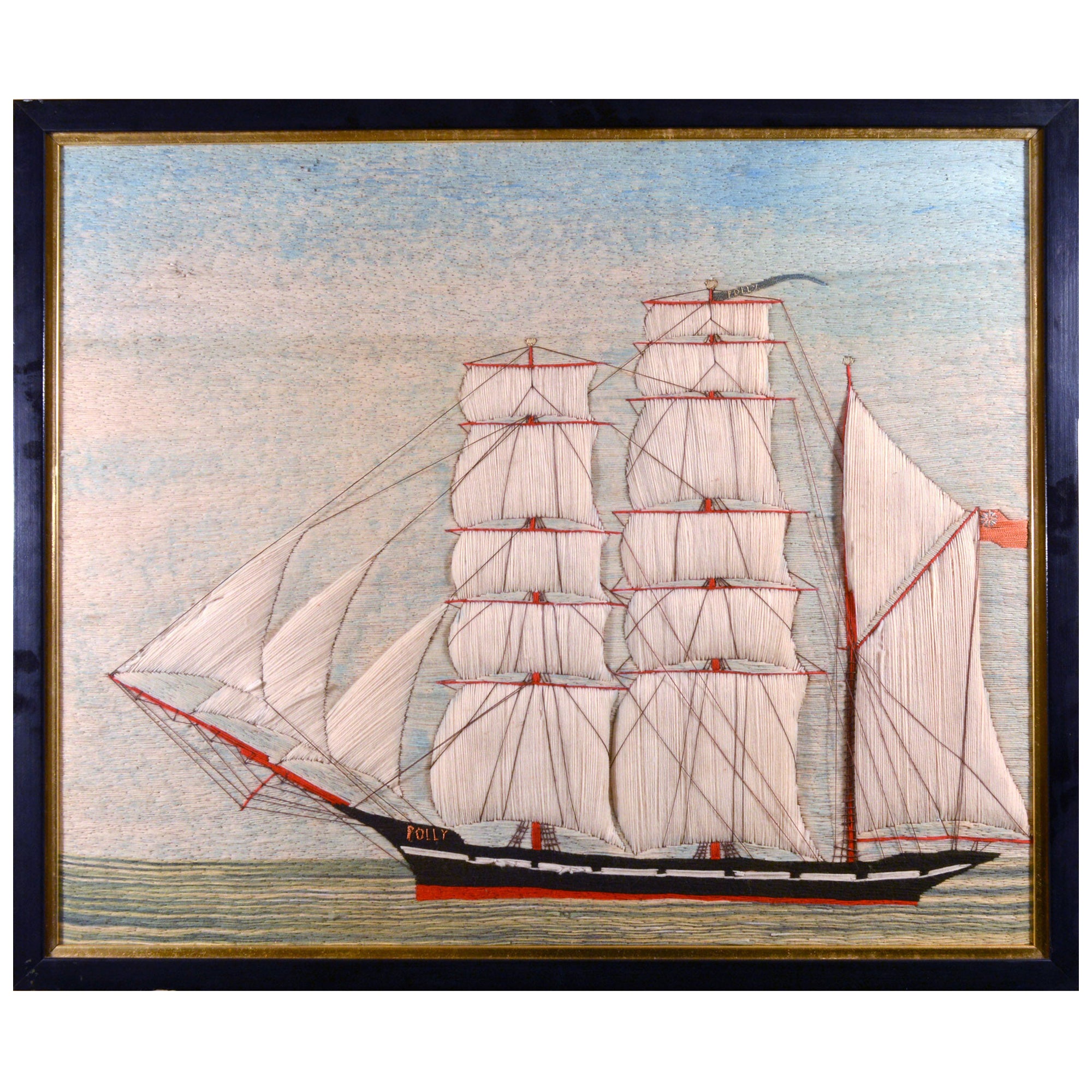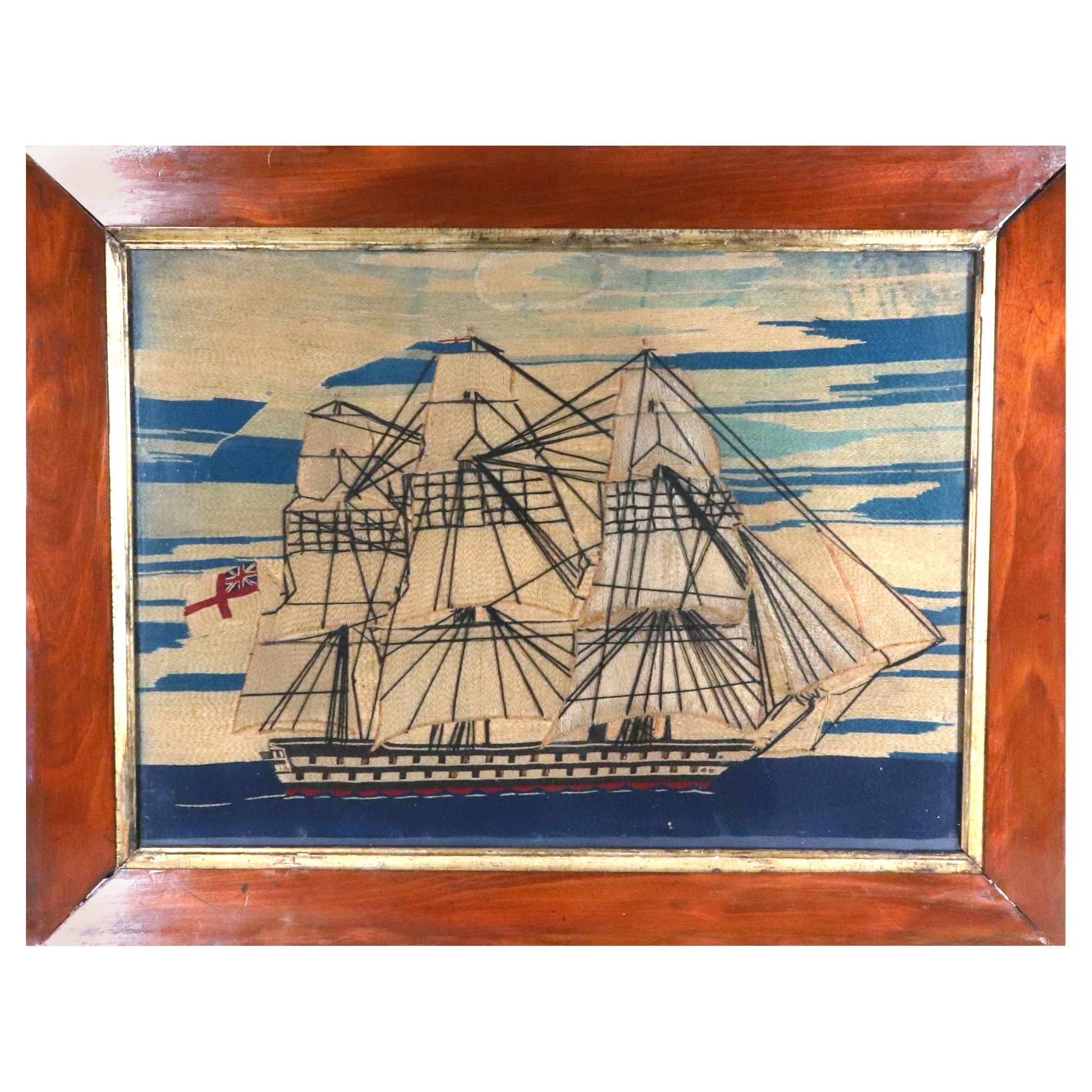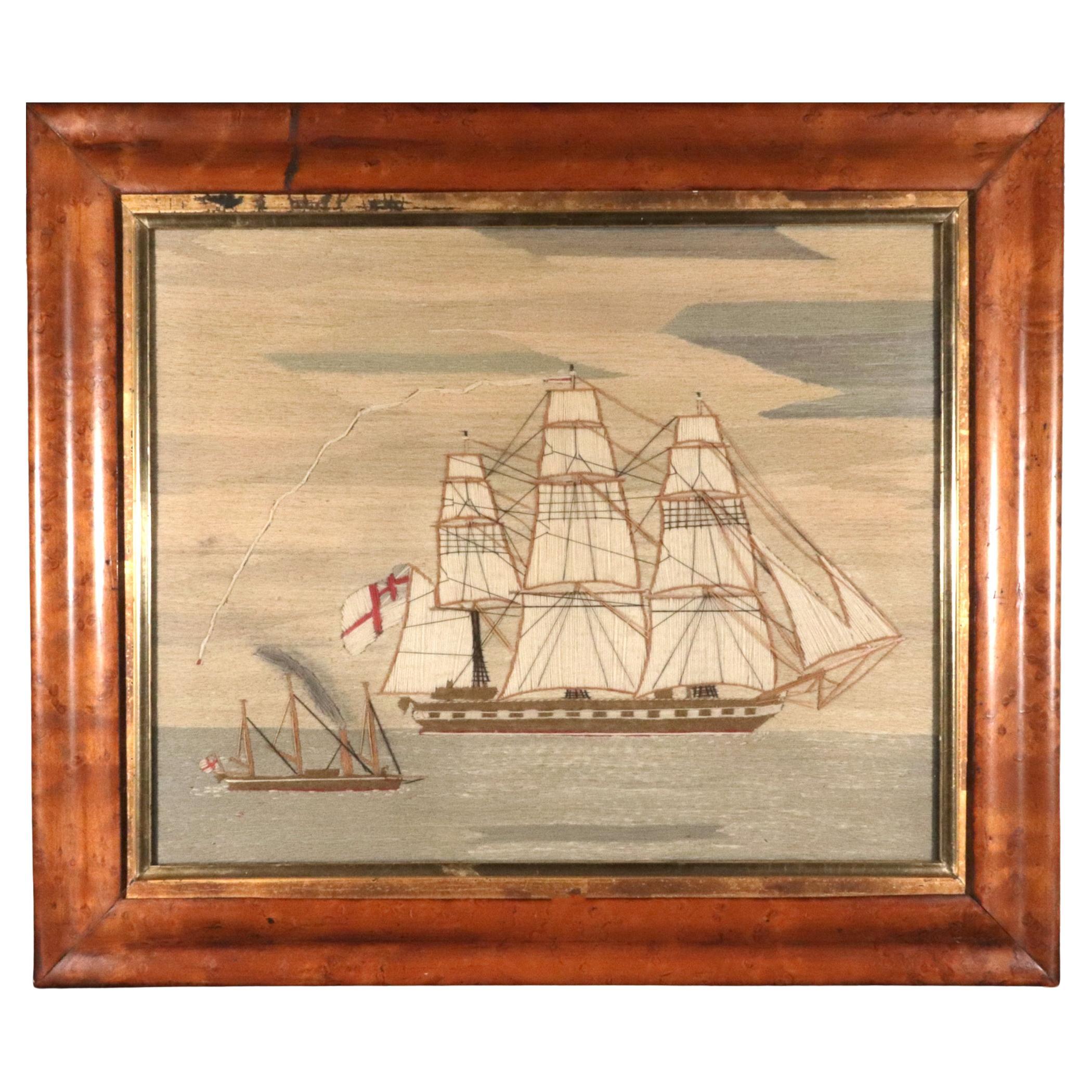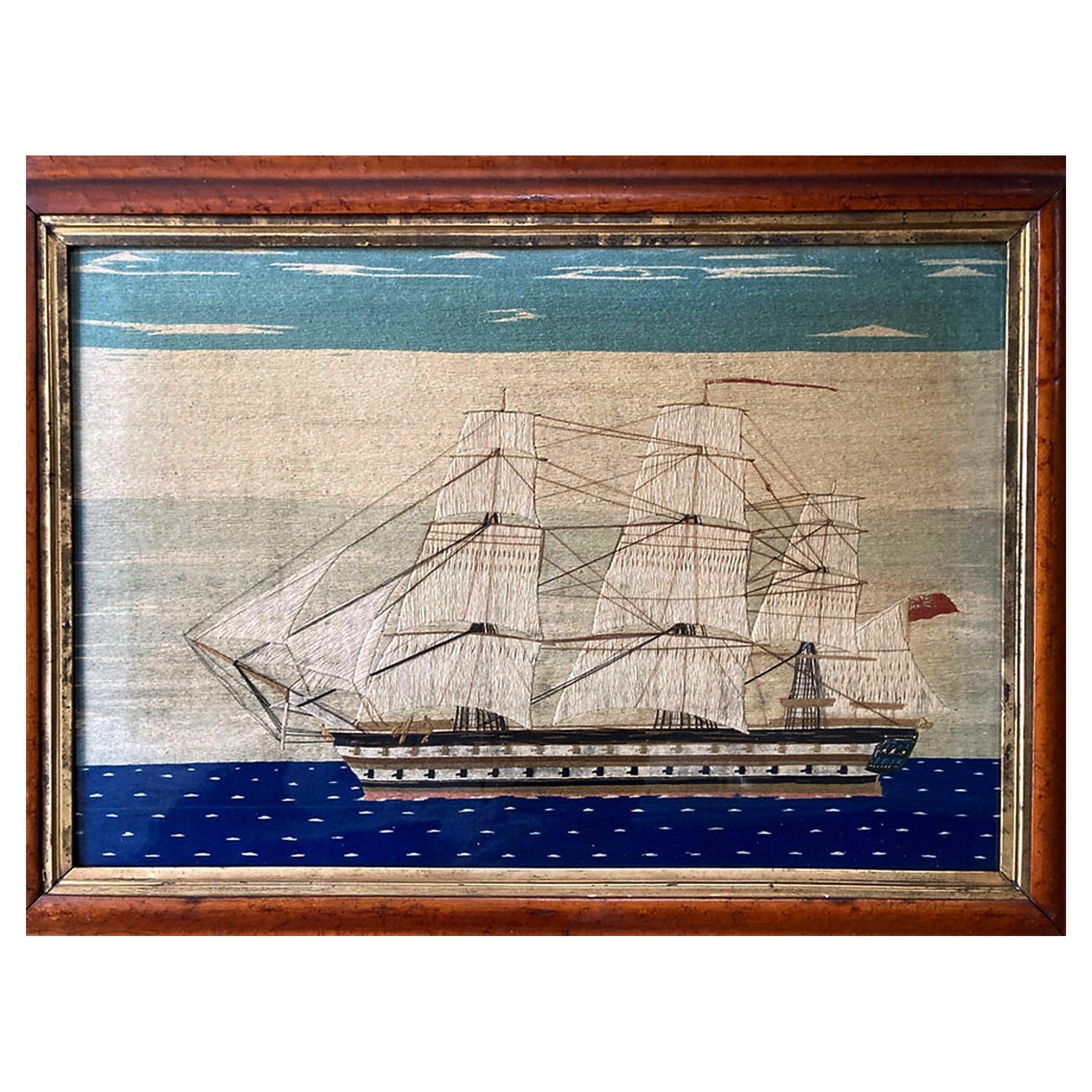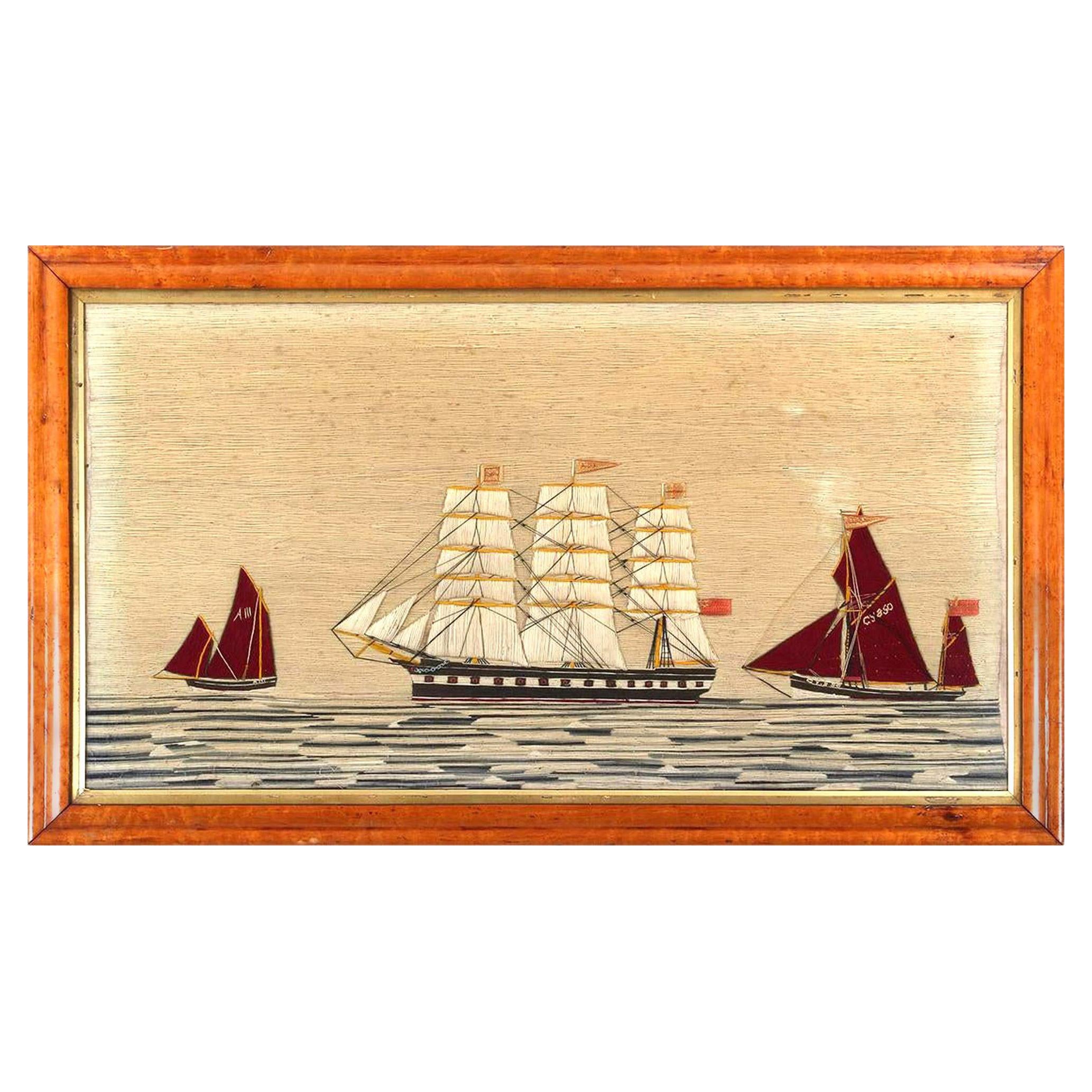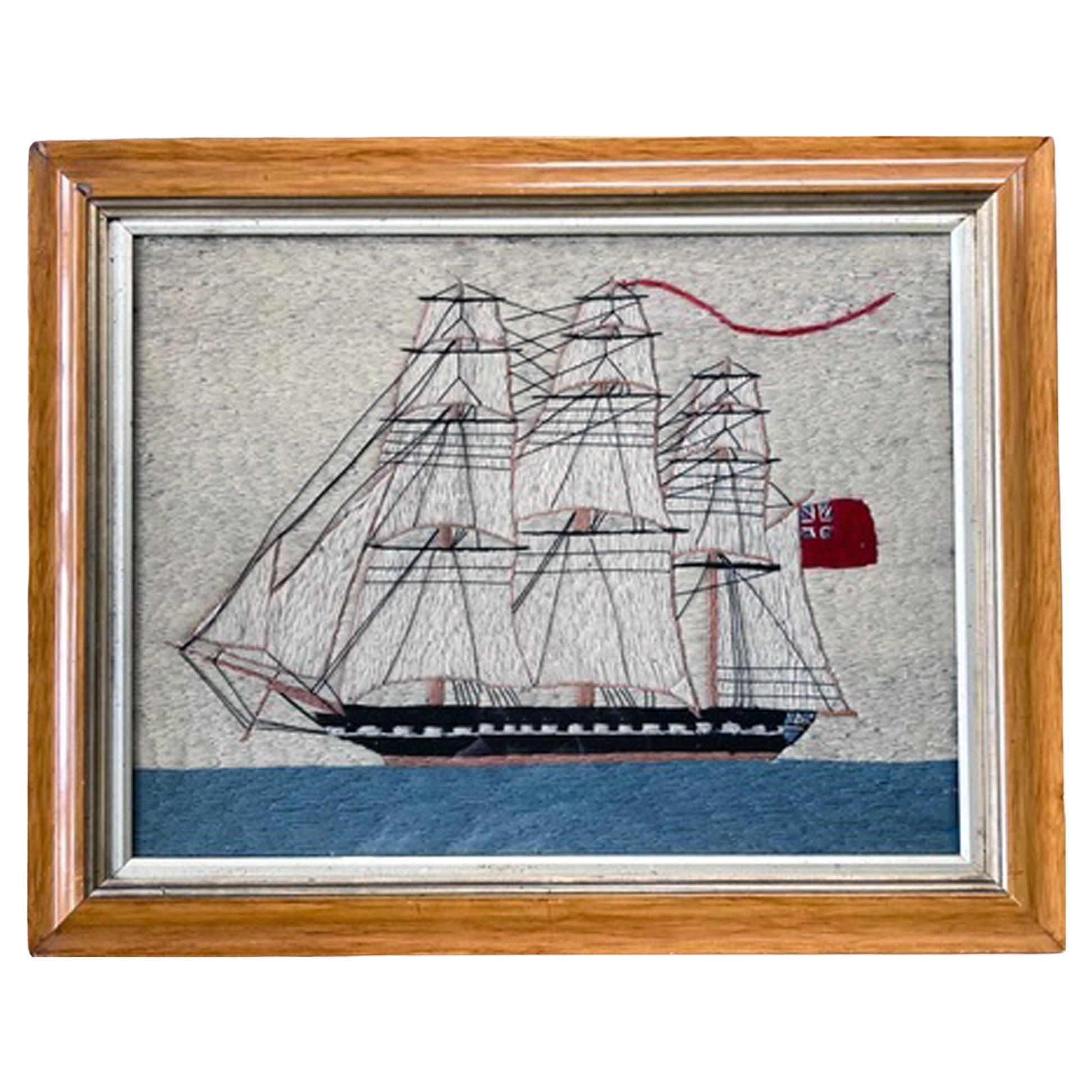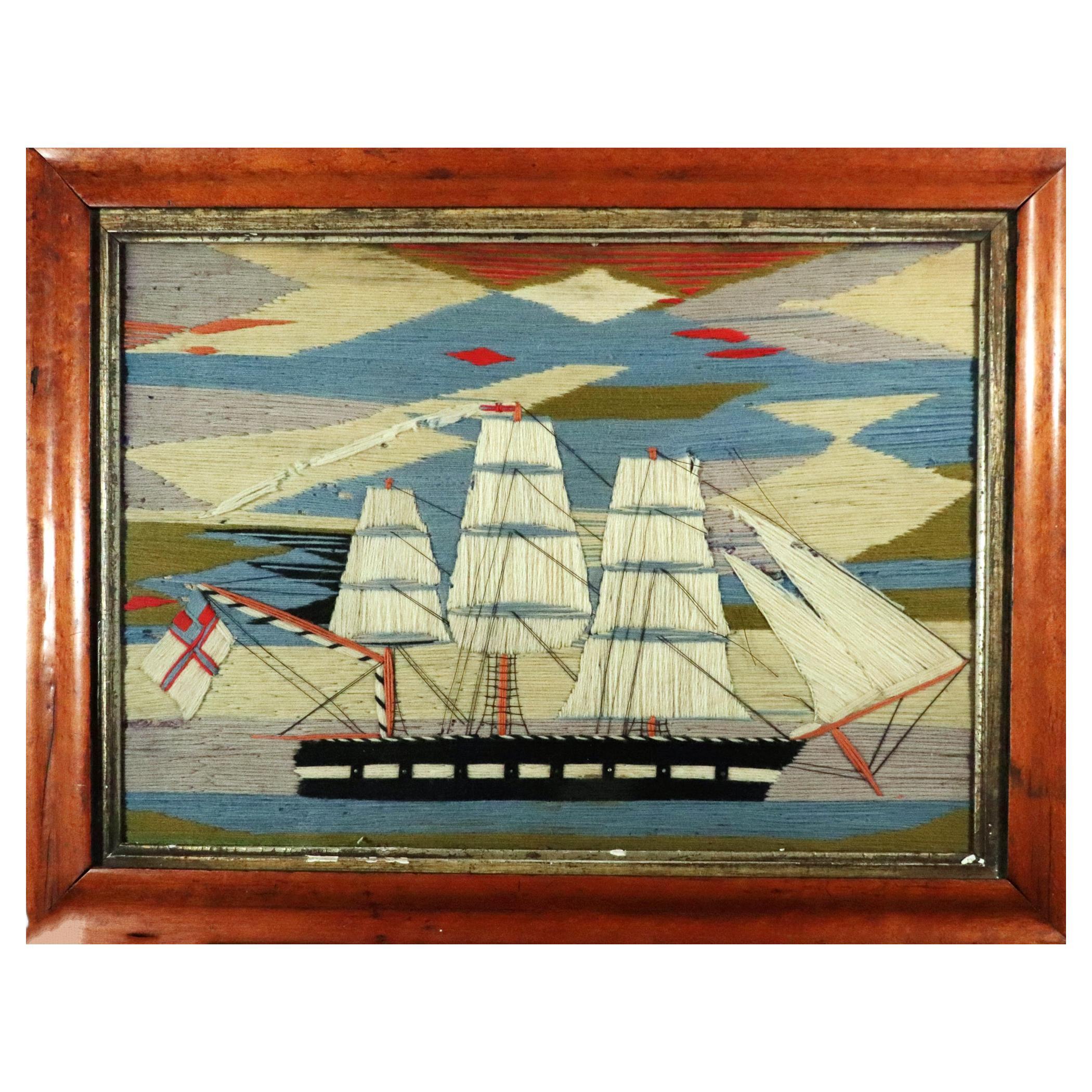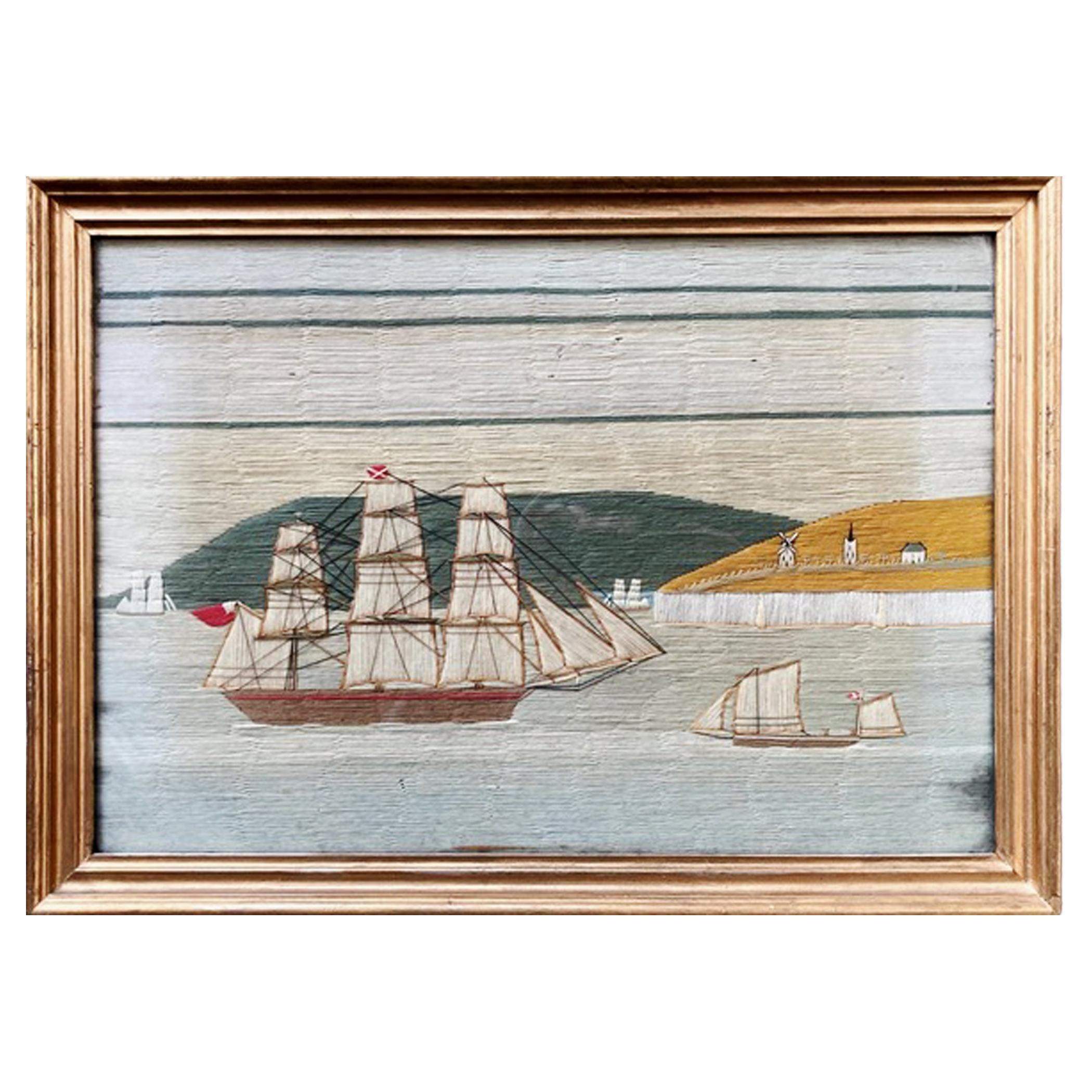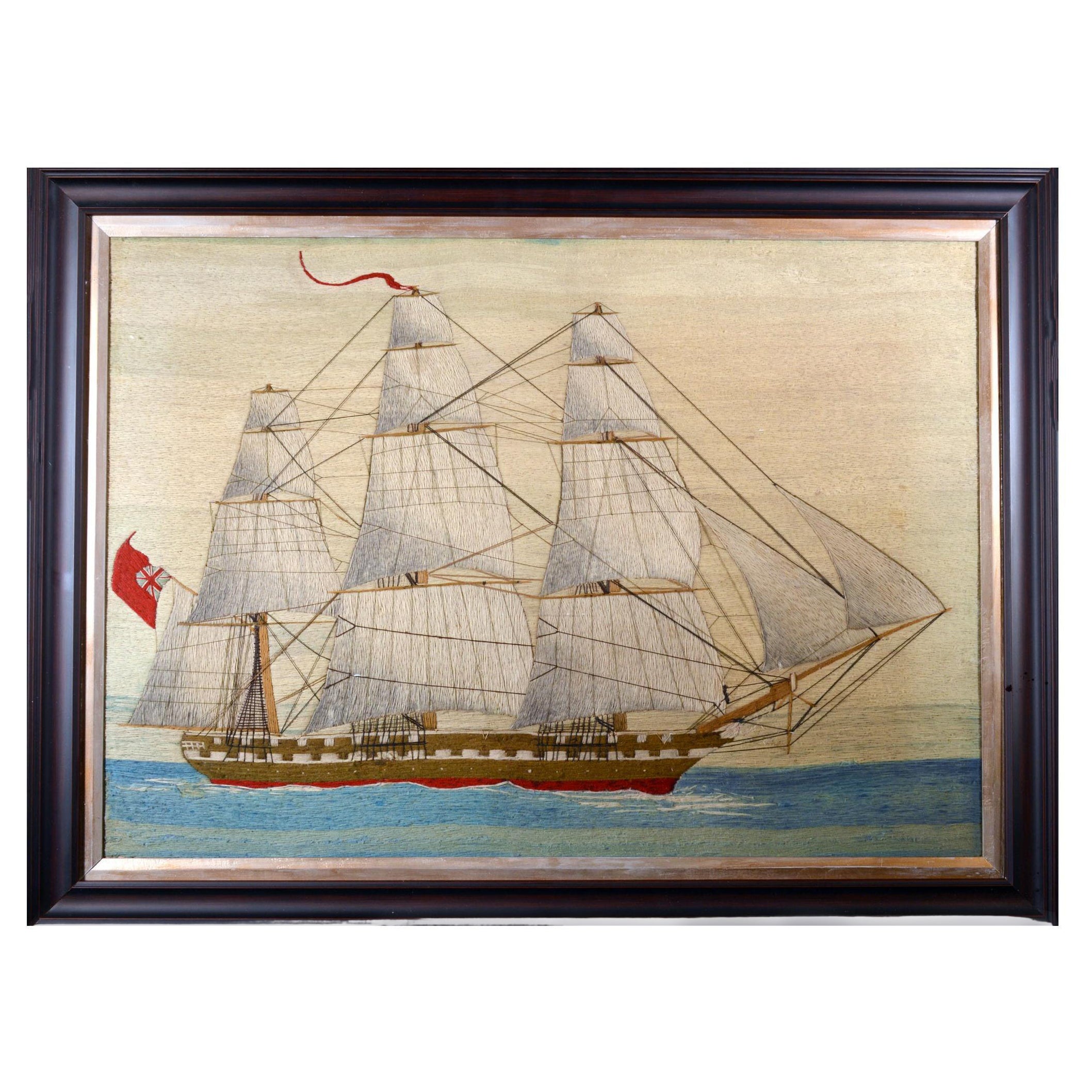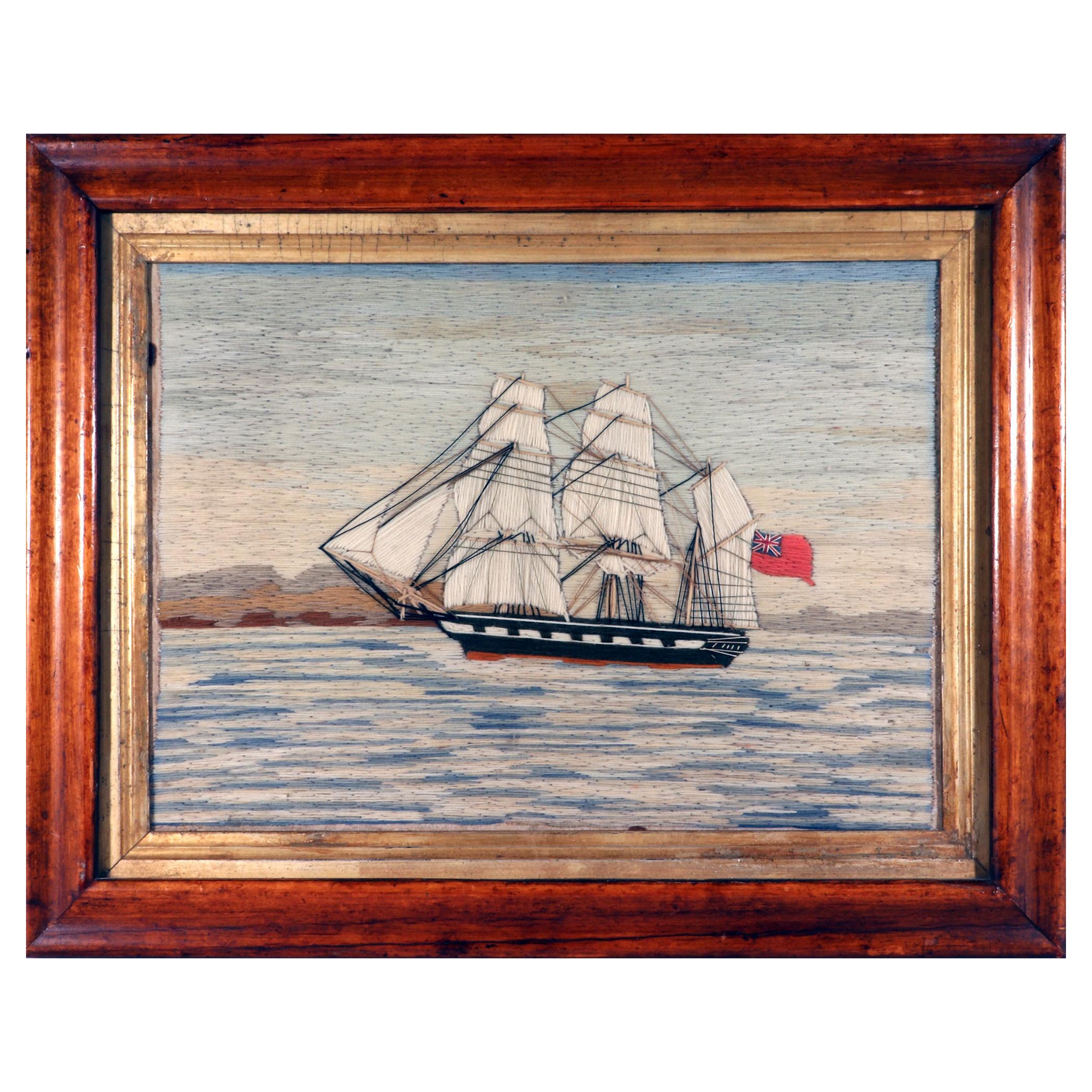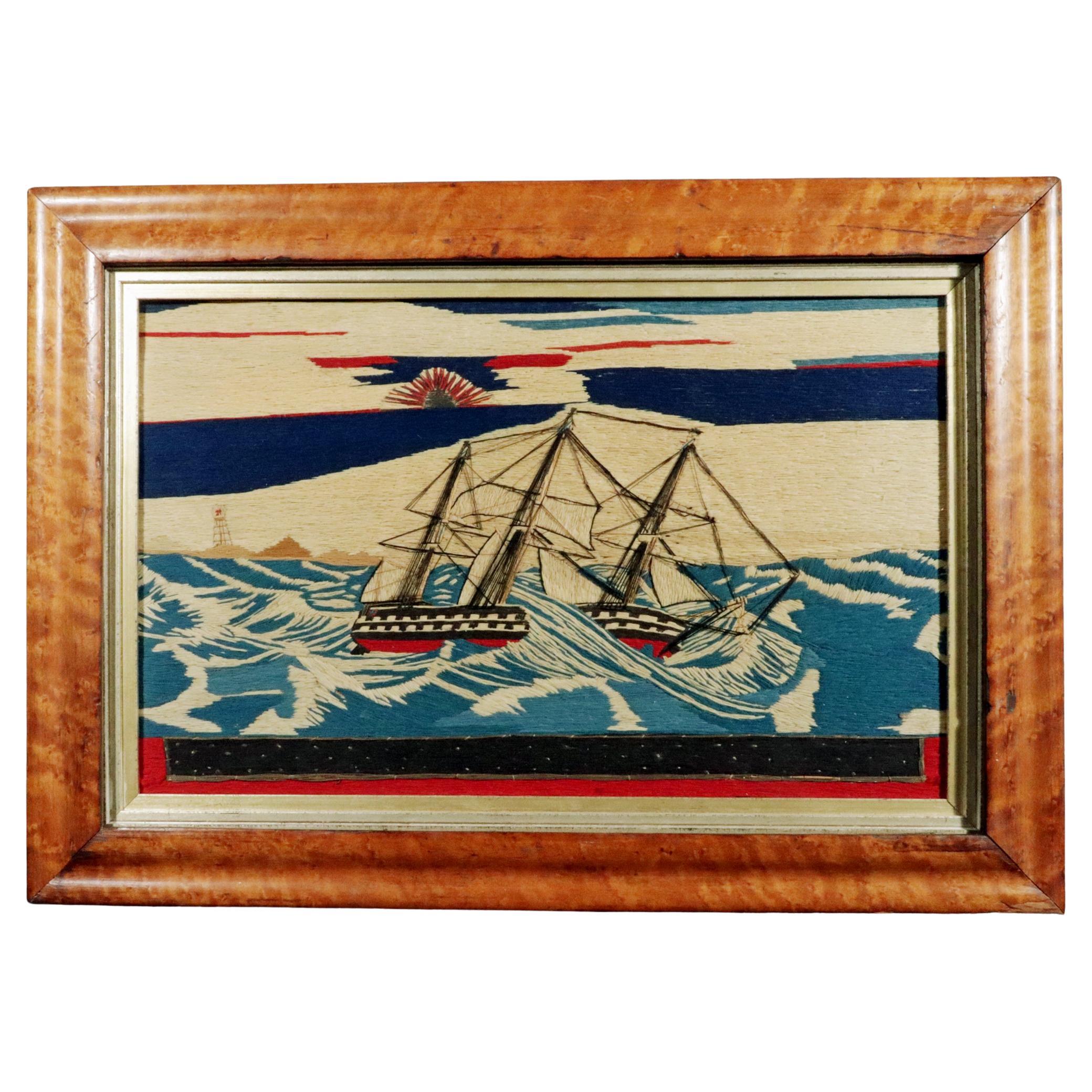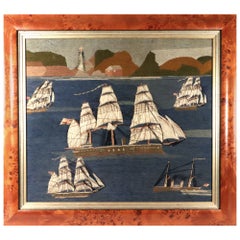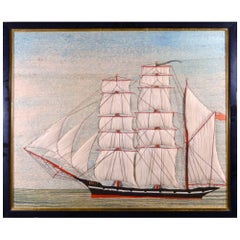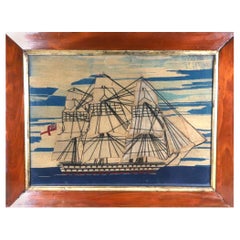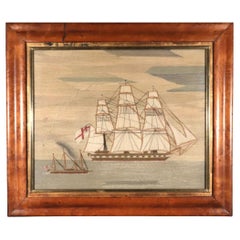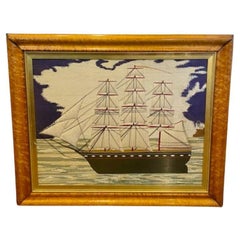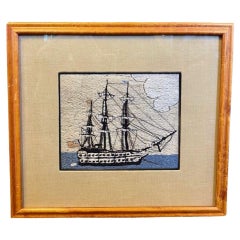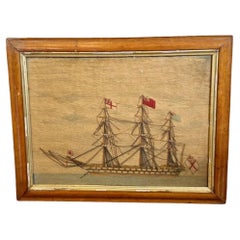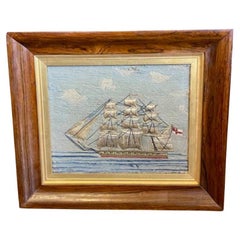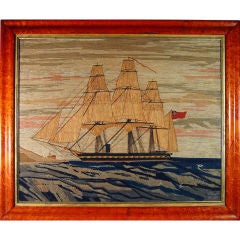
A Large British Sailor's Woolwork (woolie) Picture of the Ship
View Similar Items
Want more images or videos?
Request additional images or videos from the seller
1 of 7
A Large British Sailor's Woolwork (woolie) Picture of the Ship
About the Item
Reference:
H.M.S. Aurora was a wood frigate launched at Pembroke Docks on the 22nd of June 1861.
She was broken up in December 1881.
She was 227 feet long x 50 feet
and carried
One 110 lb gun,
Eight 8inch guns,
Four 70lb gun
Eight 40 lb guns,
Eighteen 32lb guns.
HMS Aurora, Cananda
(http://www.battleships-cruisers.co.uk/converted_frigates.htm)
HMS 'Aurora' at Heligoland, 9th May 1864
by Ian Harvie
An observant witness of the fight between the Danish and Austrian squadrons off Heligoland on 9th May 1864 was the Royal Navy frigate Aurora. Aurora, commanded by Captain Sir Leopold McClintock, was despatched to Heligoland on receipt of news that an Austrian squadron was on its way to the North Sea.
The Danish cause attracted widespread sympathy in Britain throughout the conflict with Austria and the North German Confederation: indeed, the Prime Minister, Palmerston, and his Foreign Secretary, Russell, strongly favoured some form of armed intervention on Denmark's behalf but could carry neither the Cabinet nor, for that matter, Queen Victoria with them.
More importantly, neither could ignore the advice of Britain's senior military advisor, the Commander-in-Chief of the army, the Duke of Cambridge, that military intervention was impracticable given the reduced state of the army. British impotence on land was not going to deprive Palmerston of a show of belligerence however. He told Austria's ambassador in London that the passage of Austrian warships through the Channel would be "an affront and insult to England" and that any attempt to enter the Baltic would be opposed by a more powerful British fleet.
In the meantime, Aurora was ordered to Heligoland to mount guard over the territory acquired from Denmark in 1814, whilst Admiral Dacres' Channel Fleet was tasked with shadowing the main Austrian fleet when it entered the Downs.
Captain Sir Leopold McClintock
Captain Sir Leopold McClintock
The arrival of Captain Tegetthoff's advance squadron at Cuxhaven on 4th May did not go unmonitored. McClintock left Heligoland in the tender Black Eagle to observe the Austrian ships as they lay at anchor.
He did so out of uniform, hoping to remain inconspicuous, whilst Aurora remained on station. As soon as it became clear that the Austrians were preparing to put to sea again, McClintock returned to the Aurora and, weighing anchor, positioned himself outside Cuxhaven in readiness for their departure.
On 7th May the Austrian ships slowly made their way out of harbour. For a moment Tegetthoff appears to have mistaken Aurora for a Danish vessel as he steered towards her under full sail. He quickly turned away however when he realised his mistake.
On the following day McClintock sighted Suenson's North Sea squadron and, after putting a lieutenant aboard the Danish flagship, Niels Juel, learned of their intention to engage the Austrian's the next day.
Around noon on 9th May the opposing squadrons steamed into view south of Heligoland. McClintock immediately got under way and took up a position three miles offshore so as to clearly establish the limits of British territorial waters. As the fleets closed to within range of each other McClintock ascended Aurora's main topmast to watch the action develop. Crowds of spectators lined the shoreline as well hoping to catch sight of the ensuing battle. Distance and the smoke of gunfire obscured the view however.
At around 3.40 p.m. the Austrian flagship, Schwarzenberg, was seen emerging from the smoke with her foremast, rigging and forecastle ablaze, closely followed by other units of the Austrian squadron and the Danes, who continued firing at Tegetthoff's fleeing ships. Suenson finally broke off the action at around 4.30 when McClintock interposed Aurora between the two antagonists, though the Danish ships remained on station for a time to watch over any sudden Austrian attempt to leave the sanctuary of neutral waters.
It was clear however that both Schwarzenburg and Radetzky were seriously damaged: indeed, Schwarzenburg's foretop collapsed as she sailed past Aurora towards Heligoland. During the night McClintock watched attempts to extinguish the flames and make the ships seaworthy. He offered Tegetthoff medical assistance to tend his wounded but this was rejected. Tegetthoff appears to have suspected McClintock's motives.
A few days earlier, on their way north, the Prussian gunboat Seehund, attached to Tegetthoff's squadron, ran aground and suffered significant damage when under a British pilot entering Ramsgate harbour. Tegetthoff apparently considered this to have been a malicious act on the part of the British and became wary of accepting further offers of help. Later that evening McClintock sent Black Eagle home to England with despatches announcing a Danish victory. A few hours later, blacked out and under cover of darkness, Tegetthoff left British waters to return to Cuxhaven.
Did Aurora's presence prevent Suenson finishing off his enemy? International law concerning the rights of a belligerent to pursue enemy vessels into neutral waters was by no means codified at this time. And there were plenty of precedents for its violation - especially by the Royal Navy. In 1759 Admiral Boscawen pursued a French squadron into the neutral Portuguese waters of Lagos Bay and burnt and captured several enemy ships.
And in 1940 HMS Cossack flouted Norwegian neutrality to rescue British POWs on board the German supply ship Altmark in Jössingfjord. A nation's right to have its waters respected depended in reality on its capacity to enforce its neutrality by force of arms. Many in Britain would have welcomed the destruction of the Austrian squadron, but not at the expense of liberties being taken with British sovereignty. The country was especially sensitive to neutrality issues at the time following a dispute with the USA during their secessionist war when a British ship, Trent, was intercepted by a US vessel on the high seas and Confederate agents forcibly removed.
Palmerston threatened war with the Northern States until Lincoln's government issued a fulsome apology. A strongly worded protest, as well as some sabre-rattling, would undoubtedly have followed any Danish incursions into Heligoland waters, but in view of Palmerston's public stance in favour of Denmark's cause, and Britain's strategic interests, any stronger action seems unlikely. As it was, by her presence, Aurora ensured that no diplomatic complications ensued, with the result that when news of the Danish victory was announced in the House of Commons that same day it met with a degree of acclamation which would not have shamed a British naval triumph.
(http://www.pdavis.nl/ShowShip.php?id=74)
Name Aurora
Type Frigate
Launched 22 June 1861
Hull Wooden
Length 212 feet
Propulsion Screw
Men 540
Builders measure 2558 tons
Displacement 3498 tons
Guns 51
Fate 1881 Last in commission 1877
Class Forte
18 November 1863- 7 September 1865
Commanded (from commissioning at Plymouth) by Captain Francis Leopold McClintock, Channel squadron, and - September 1864 - to escort the Royal yacht Osborne, taking the Prince and Princess of Wales (later King Edward VII and Queen Alexandra) to Copenhagen and the Baltic, then (January 1865) North America and West Indies
1 November 1865- 20 December 1867
Commanded (until paying off at Plymouth) by Captain Algernon Frederick Rous De Horsey, North America and West Indies, senior officer on the Canadian lakes (during the Fenian disturbances)
20 February 1872- 21 August 1872
Commanded (from commissioning at Plymouth) by Captain Benjamin Spencer Pickard, sea-going training ship for boys.
21 August 1872- 20 April 1874
Commanded (until paying off at Plymouth) by Captain Sholto Douglas, 1873 detached squadron, then temporary flagship at Queenstown
15 May 1874- 10 August 1874
Commanded by Captain William Graham, Coast Guard, Greenock
10 August 1874- 12 July 1875
Commanded by Captain Trevenen Penrose Coode, Coast Guard, Greenock
12 July 1875 Commanded by Captain Henry Duncan Grant, Coast Guard, Greenock
19 June 1877 Paid off.
December 1881 Broken up at Devonport.
Extracts from the Times newspaper
Th 7 July 1864 A NAVAL ENCAMPMENT.-In consequence of the epidemic of smallpox which has appeared on board Her Majesty's ship Racoon, while lying in Leith Roads, it has been resolved to encamp the crew for a time on the island of Inchcolm, near Burntisland, and a supply of tents and camp apparatus from Edinburgh Castle has been sent to the island for that purpose. One of the sailors taken ashore died on Monday in the Edinburgh Infirmary, and several others are lying ill there. Meantime the vessel, which lies off the island, is to be subjected to a thorough purification. Prince Alfred, who came ashore on Saturday, is still residing at Edinburgh, waiting the arrival of the Aurora, Captain Sir Leopold M'Clintock, which it is understood he is now to join. On Monday he visited the studios of Mr. Steell and Mr. Brodie, sculptors.
Sa 16 July 1864 The encampment of the crew of Her Miajesty's ship Racoon, Count Gleichen, on the island of Inchcolm, Firth of Forth, is to be broken up to-day. The Racoon arrived in the Forth on the 29th of June to coal before going out on a cruise on the coast of Norway with Prince Alfred. On arriving there two malignant cases of smallpox were reported, and in two other cases the disease seemed to be threatened. The invalids were removed to the Royal Infirmary of Edinburgh, where one of them died after four days' illness, and where the second still remains; the two suspected cases did not prove to be smallpox, and they have recovered. The proposal was immediately made to encamp the crew on shore and thoroughly cleanse the ship. The small island of Inchcolm was selected as the camping ground, and tents were procured from Edinburgh Castle. The Racoon selected an anchorage in the sound between the island and the Fifeshire coast, and about 30 men were left on board to purify and fumigate the ship. The crew were specially inspected by the medical officers, and those who did not show satisfactory marks of vaccination were subjected to the operation. The health of the men on shore has been excellent, and the ordinary sick list has daily been diminishing until it has been reduced not only below the average, but almost to a blank return. The steps taken have not only put a stop to what threatened to be a severe outbreak of epidemic disease, but greatly improved the general health of the crew. On the re-embarkation of the men, and after the necessary preparations have been made for sailing, the Racoon will leave the Firth of Forth and proceed to Fröyen in Norway, where Prince Alfred, who has meantime gone out in the Aurora, will rejoin his ship.
Tu 2 August 1864 THE AURORA.- The steam frigate Aurora, Captain Sir Leopold F. M'Clintock, which left about a fortnight ago with Prince Alfred for Norway, returned to her anchorage in Burntisland Roads on Friday afternoon. Since landing the Prince in Norway she has been on a ten days' cruise, during which she has experienced rather stormy weather. She fell in with the Racoon at Christiansand, whither that vessel has gone to receive the Prince again on the termination of his Norwegian tour. It is not certain how long she will remain at her present anchorage.- Scotsman.
Ma 9 December 1872 The Aurora, 28, screw frigate, Capt. Sholto Douglas, is ordered to join the Detached Squadron, and will probably leave Plymouth Sound to-day for the rendezvous in Portland Roads
Fr 20 December 1872 Shortly before 12 o'clock on Wednesday morning the Flying Squadron, which for the past fortnight have been rendezvousing inside Portland breakwater, left for a short cruise. The vessels consisted of the Narcissus, bearing the flag of Rear-Admiral Frederick Campbell, the Immortalité, the Doris, the Topaze, the Valorous, and the Aurora. They proceeded under steam to the westward. It is expected the fleet will return either on Sunday or Monday.
Sa 21 December 1872
The detached squadron, comprising the following ships, put into Plymouth Sound yesterday for shelter from the southerly gale blowing in the Channel :- The wood-built unarmoured screw frigates Narcissus, 28, Capt. J.O. Hopkins, bearing the flag of Rear-Admiral F.A. Campbell, commanding-in-chief the squadron; the Aurora, 23, Capt. Sholto Douglas; the Immortalité, 23, Capt. W. Graham; the Doris, 24, Capt. W.H. Edye, and the Topaze, 31, Capt. E. Hardinge; the Narcissus has started her cutwater and the Aurora her bowsprit, which, with other defects, will necessitate their going into the harbour at Devonport to repair.
Tu 24 December 1872
The screw frigates Topaze, 31, Capt. Hardinge, and Doris, 24, Capt. W.H. Edye, proceeded from Plymouth Sound to the westward yesterday morning, to relieve homeward bound vessels.
The screw frigate Aurora, 28, Capt. Sholto Douglas, moved from the Sound into the harbour at Devonport yesterday, to have defects remedied; the two other ships of the detached squadron, the Narcissus, flagship of Rear-Admiral F.A. Campbell, and the Immortalité, remain in Plymouth Sound.
Ma 13 January 1873
The Aurora, 28, screw frigate, Capt. Sholto Douglas, steamed from the basin at Devonport Dockyard into Plymouth Sound on Saturday. Several petty officers and able seamen, in the various messes, who, from the evidence adduced at the recent Court of Inquiry, appear to have originated the disturbance on board the Aurora, are to be dismissed the ship and disrated. No change will occur among the officers, and the Aurora will remain with the Squadron.
Sa 18 January 1873
The unarmoured screw frigate Endymion, Capt. Maddan, sailed from Spithead about 3p.m. yesterday, for the present anchorage of the Detached Squadron in Vigo Bay. The frigate left Spithead under all plain sail, with a light breeze from about west-north-west.
The Doris, 24 screw frigate, Capt. W.H. Edye, will sail from Plymouth Sound for Vigo on Monday morning, and will take a mail for the Narcissus, Topaze, and Aurora.
Th 23 January 1873 Letters for the ships of the Detached Squadron, Narcissus, Topaze, Endymion, Doris, and Aurora, may be sent to Madeira by mail of the 25th. inst., after that date to Barbadoes until further notice.
Ma 3 February 1873 The ships of the Detached Squadron having been delayed by bad weather, letters for the Narcissus, Topaze, Aurora, Doris, and Endymion should be sent by mail of the 5th. inst. to Madeira, instead of Barbadoes.
We 26 February 1873
Private letters received at Woolwich from Vigo report the arrival at that port of the Flying Squadron, under the command of Rear-Admiral F.A. Campbell, consisting of the Narcissus, 28, flagship, Capt. J.O. Hopkins; the Aurora, 23, Capt. S. Douglas ; the Doris, 24, Capt. W.H. Edye; the Endymion, 22, Capt. E. Maddon; the Topaze, 31, Capt. E. Hardinge. The passage from Plymouth was very boisterous, the whole of the ships of the squadron having encountered tremendous weather in the Bay of Biscay, the hurricane lasting from the forenoon of the 18th to the 27th ult. The Aurora, the Narcissus, and the Topaze each lost a man overboard, The Aurora was battened down for three days, leaking much from her continued labouring, and the Topaze encountered such a succession of tremendous seas as rendered it doubtful whether she would be able to recover herself. The whole of the vessels sailed for Barbadoes on the 6th inst, where they will be joined by the Immortalité, 28, Capt A.M'L. Lyons.
Tu 1 April 1873
The Flying Squadron, under command of Rear-Admiral F.A. Campbell, arrived at Barbadoes on the 4th of March, 10 days from Madeira and 26 days from Vigo. The squadron left Madeira with a north-east wind and had a pleasant run down the Trades, which were met with on the 25th of February. Typhoid fever has broken out on board the Narcissus and Doris, the flagship having several serious cases, besides about 50 men on the sick list suffering from boils and ulcers. The military medical authorities at Barbadoes declining to take the fever patients into their hospital, Admiral Campbell sent the Doris with her own sick and with 14 others from the Narcissus to Bermuda. The fever is attributed to the water taken on board at Vigo, although it was tested previously and pronounced perfectly good. The sailing qualities of the ships as tested during the cruise place them in the following order of merit:- Aurora, Narcissus, Topaze, Doris, and Endymion. The squadron will leave Barbadoes on the 14th. of March for Trinidad, en route for Port Royal.
We 23 May 1877
The Immortalité, 28, Acting Capt. Noel, which, with the Newcastle, 31, Capt. Douglas, arrived at Portsmouth a few days ago on the termination of the cruise of the Detached Squadron, was paid off, all standing, on Monday morning.
The Immortalité was commissioned at Portsmouth on the 14th of October, 1872, by Capt. Algernon M'L. Lyons, and on the 8th of December arrived at Portland, the rendezvous of Admiral Campbell's squadron. A few days later, the squadron, which consisted of the Narcissus (flagship), Immortalité, Aurora, Endymion, and Doris, anchored at Plymouth. After a short stay, the Immortalité was despatched to the Irish Channel in search of a derelict, the Margaret Pollock, which Captain Lyons succeeded in finding. Owing, however, to a continuance of heavy gales, he was unable to keep in company with her, and as his ship had started a serious leak it was deemed advisable to return to port, and she accordingly put back to Portsmouth on the 6th of January, 1873. The necessary repairs took more than a month to complete. In the meantime Admiral Campbell left with the other ships of the squadron for Madeira and the West Indies, the Immortalité joining company with them at Barbadoes on the l1th of March. The squadron then proceeded to Trinidad, thence to Jamaica, touching at several ports in the Windward Islands and at St. Domingo, and onward to Halifax, where orders reached them to proceed to Gibraltar, which port they reached on August 8, 1873. The squadron was then employed for some months on the coast of Spain in consequence of certain difficulties arising out of the Civil War in that country, and more particularly on account of the Intransigentes, who, having possessed themselves of several Spanish men-of-war, were behaving in a somewhat novel and irregular manner. The squadron cruised about from port to port, sometimes singly and sometimes in company, the officers taking the opportunity offered by their stay at Malaga to visit Granada, Seville, and Cordova. On the 17th of November the Immortalité was detached on a cruise to the coast of Morocco, as the bearer of the usual congratulations to the new Emperor on his accession to the Throne; and having first called at Tangier to embark the Moorish Minister, Seyd Mahomed Bargash, family, and suite, she proceeded to Rabat, where the Emperor was residing with a large following of motley, but picturesque, troops. Capt. Lyons and some of his officers were presented to the Emperor. After this incident the squadron was ordered to Malta, and, after refitting, cruised on the station until June, when it returned to Gibraltar, having visited Corfu, Athens, Smyrna, Candia, Palermo, Sardinia, and other places. The Doris was then ordered to Halifax, but the remainder of the ships returned to England, where they were paid down and new captains and several officers appointed, Rear-Admiral Randolph being placed in command. On the 20th of September, l874, the squadron, which now consisted of the Narcissus, Immortalité, Topaze, Newcastle, Raleigh, and Doris, the Immortalité being commanded by Capt. Hume, again left England, and, after touching at various places, arrived at the Cape of Good Hope on the 3d of April, 1875, where they remained a mouth to refit. The vessels returned to Gibraltar by St. Helena, Ascension, and St. Vincent, and shortly afterwards received orders to repair to Bombay to await the arrival of his Royal Highness the Prince of Wales; Rear-Admiral Rowley Lambert, C.B., being at the same time appointed to the command. The squadron arrived at Bombay on the 6th of September, after a tedious passage of 91 days, and one week at the Cape, which was not more than sufficient for the performance of all necessary duties. Everybody in the squadron had opportunities of visiting famous places, seeing wonderful sights, and receiving Indian hospitality. After a considerable stay at Bombay the squadron visited Colombo, Trincomalee, and Calcutta, and then returned to Bombay. The orders were out, and the ships were to have sailed in a week for the Suez Canal, when, owing to Chinese troubles, a telegram arrived in time to arrest their return and to despatch four ships - the Narcissus, Immortalité, Topaze, and Newcastle - to Singapore and Hongkong, where they arrived on the 7th of April, 1876. The squadron remained in Chinese waters during the negotiations between the two Governments, and visited Shanghai, Amoy, Japan, Chefoo, and Talien. When at Chefoo Admiral Lambert hoisted his flag on board the Immortalité, and proceeded to the Taku Forts, at the mouth, of the Peiho River. Here the Commander-in-Chief, Admiral Ryder, and Staff, accompanied by Sir Thomas Wade and Admiral Lambert and Staff, proceeded up the river in the Vigilant and Mosquito to Tientsin, and thence to Pekin. Several officers of the Immortalité also visited Pekin and the great wall of China. Affairs having by this time been satisfactorily settled by diplomatic means, the squadron returned to Hongkong in November, 1876, and, having refitted, proceeded home, via the Mauritius, Cape of Good Hope, St. Helena, Ascension, and St. Vincent, arriving at Plymouth on the 11th inst.
In the first year of her commission the Immortalité sailed over 12,309 miles, and was 109 days at sea; in the second; 10,309 miles and 106 days; in the third, 32,423 miles and 228 days; in the fourth, 14,491 miles and 134 days; and in the fifth, 16,824 miles and 120 days. During the whole commission, therefore, she had sailed over 86,356 miles, and been 897 days at sea, and 975 days in harbour, including 175 days fitting out, docking for repairs on her return from the Irish Channel, paying down and fitting out the second time at Portsmouth. In the five years she was 111 times in port, and visited 76 different ports, of which 69 were foreign and colonial. The following are the names of the officers who have served in the Immortalité the whole of her commission, from October, 1872 :- Commander Alan B. Thomas, Lieut. of Marines T.K. Byam, Chaplain, the Rev. A. Nicholls, B.A.; Paymaster, W. Warburton; Sub-Lieuts. J. W. Litle and Montgomerie; Surgeons C.G. Wodsworth and I.H. Anderson; Engineer, G.F. Greaves; boatswain, John Mahoney; acting Sub-Lieut. Haswell, and Navigating Sub-Lieut. Scott. Fleet Surg. J.C. Ingles served from the 4th of February, 1873. The Immortalité will be paid off into the 4th Division of the Steam Reserve, and, as her hull is sadly out of repair, she will not probably be again called upon for service at sea.
- Dimensions:Height: 20.5 in (52.07 cm)Width: 25.5 in (64.77 cm)
- Materials and Techniques:
- Place of Origin:
- Period:
- Date of Manufacture:Circa 1870
- Condition:
- Seller Location:Downingtown, PA
- Reference Number:Seller: NY72081stDibs: U090622861087
About the Seller
5.0
Recognized Seller
These prestigious sellers are industry leaders and represent the highest echelon for item quality and design.
Gold Seller
Premium sellers maintaining a 4.3+ rating and 24-hour response times
Established in 1916
1stDibs seller since 2009
407 sales on 1stDibs
Typical response time: 1 hour
Associations
The Art and Antique Dealers League of AmericaAntiques Associations Members
Authenticity Guarantee
In the unlikely event there’s an issue with an item’s authenticity, contact us within 1 year for a full refund. DetailsMoney-Back Guarantee
If your item is not as described, is damaged in transit, or does not arrive, contact us within 7 days for a full refund. Details24-Hour Cancellation
You have a 24-hour grace period in which to reconsider your purchase, with no questions asked.Vetted Professional Sellers
Our world-class sellers must adhere to strict standards for service and quality, maintaining the integrity of our listings.Price-Match Guarantee
If you find that a seller listed the same item for a lower price elsewhere, we’ll match it.Trusted Global Delivery
Our best-in-class carrier network provides specialized shipping options worldwide, including custom delivery.More From This Seller
View AllBritish Sailor's Woolwork Picture of Five Ships Off a Coastline
Located in Downingtown, PA
British Sailor's Woolwork Picture of Five Ships offshore,
Circa 1875
The large sailor's woolwork or sailor's woolie depicts five different ships. The largest ship is in the center ...
Category
Antique 1870s English Folk Art Nautical Objects
Materials
Wool
British Sailor's Woolwork or Woolie of the Named Barque "Polly"
Located in Downingtown, PA
Large British Sailor's Woolwork of the Barque Polly,
Named "Polly",
Circa 1885-95
A large sailor's woolie or woolwork of a port side view of a ship named "Polly" under full sail. The ship is rigged as a barque.
The name "Polly" can be seen on a banner flying from the mainmast and on the front of the bow and the shiop was named after the owner's wife Marian Poyy Woodside. (see below). The sails are trapunto, creating a three-dimensional look of the sails full of wind. The sea is depicted is rippling bands of green and white.
Dimensions: Frame: 26 1/4 inches high x 31 inches wide x 2 inches
Reference: The ship was built in Belfast, Northern Ireland, in 1885, and launched by Marian "Polly" Woodside, the wife of the owner, tossing flowers across the bow. (Champagne being too precious). The ship made several voyages primarily between South America and the UK before being repositioned in the Pacific.
A barque has three or four masts. The fore and mainmast are square-rigged, and the mizzen fore-and-aft, usually gaff-rigged. Carries a mainsail on each mast, but the mainsail shape differs per mast (square or gaff). Barques were built with up to five masts. Four-masted barques were quite common.
Barques were a good alternative to full-rigged ships because they require a lot fewer sailors. But they were also slower. Very popular rig for ocean crossings, so a great rig for merchants who travel long distances and don't want 30 - 50 sailors to run their ship.
A label on the reverse states that the wool was on The Antiques Road...
Category
Antique Late 19th Century English Folk Art Decorative Art
Materials
Wool
$5,135 Sale Price
35% Off
British Sailor's Woolwork of Royal Navy Ship
Located in Downingtown, PA
British Sailor's Woolwork of Royal Navy Ship,
The sailor's woolwork or woolie depicts a starboard view of a Second-Rate Royal Navy Ship with three masts. T...
Category
Antique 1870s English Folk Art Nautical Objects
Materials
Wool
British Sailor's Woolwork of Two Ships Under Way.
Located in Downingtown, PA
British Sailor's Woolwork of Two Ships,
Circa 1765-75
The British sailor's woolwork or woolie depicts a starboard view of three=masted Royal Navy ship under full sail sailing past ...
Category
Antique 1870s English Folk Art Nautical Objects
Materials
Textile, Wool
British Sailor's Large Woolwork of HMS Brunswick
Located in Downingtown, PA
British Sailor's large woolwork of HMS Brunswick,
Made by J. H. Miller, Brixton,
Circa 1865
The large-scale sailor's woolwork depicts an image of a Royal Navy Second Rate Battleship...
Category
Antique Mid-19th Century English Folk Art Decorative Art
Materials
Wool
British Large Woolwork 'Woolie' of Three Ships
Located in Downingtown, PA
Large British woolwork of three ships including the Ada and two smaller craft,
circa 1875.
The wool depicts three ships- a port side view of The Merchant ship Ada, another sail-i...
Category
Antique 1870s English Folk Art Nautical Objects
Materials
Wool
You May Also Like
19th Century Sailor's Woolie of a Black Hulled Ship
Located in Nantucket, MA
19th Century Sailor's Woolie of a Black Hulled Ship, circa 1880, a sailor's hand stitched woolwork depicting a ship-rigged vessel with deep-bodied black hull, naively under-sized sai...
Category
Antique Late 19th Century English Folk Art Nautical Objects
Materials
Wool
Petite 19th C. Sailor's Woolie of a Double Decker Ship of the Line, circa 1860
Located in Nantucket, MA
19th Century Sailor's Woolie of a Double Decker Ship of the Line, circa 1860, at anchor under furled sails, flying the British Ensign at stern and a ship's flag at mizzen peak, on th...
Category
Antique 1860s English Folk Art Nautical Objects
Materials
Wool
19th Century Sailor's Woolie of a Double Decker Ship of the Line, circa 1850
Located in Nantucket, MA
19th Century Sailor's Folk Art Woolie with a Double Decker Ship of the Line, ca 1850, depicting a larboard side view of a square-rigged double decker warship under standing rigging, ...
Category
Antique Mid-19th Century English Folk Art Nautical Objects
Materials
Wool
Antique Sailor's Folk Art Woolie of a Single Decker Ship of the Line, circa 1850
Located in Nantucket, MA
Antique Sailor's Folk Art Woolie of a Single Decker Ship of the Line, circa 1850, a sailor's folk art woolwork picture handcrafted of woolen and silk yarn in a bold variety of stitch...
Category
Antique Mid-19th Century Folk Art Nautical Objects
Materials
Wool, Silk
19th Century Sailor's Woolie with Triple Decker Ship of the Line, circa 1860
Located in Nantucket, MA
19th Century Sailor's Folk Art Woolie with Triple Decker Ship of the Line, ca 1860, depicting a starboard side view of a majestic square-rigged triple de...
Category
Antique Mid-19th Century English Folk Art Nautical Objects
Materials
Wool
19th Century Sailor's Woolie of Canadian Fort
Located in Nantucket, MA
19th Century Sailor's Woolie of Canadian Fort, circa 1860, a British sailor's folk art woolwork depicting a fleet of various sized and rigged vessels and gunboats sailing around a Ca...
Category
Antique Mid-19th Century English Folk Art Nautical Objects
Materials
Wool
